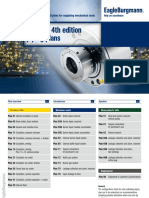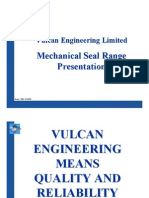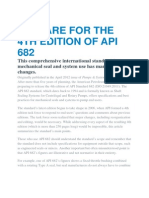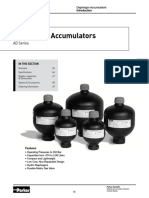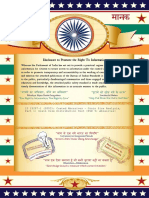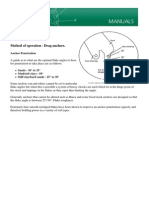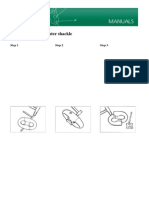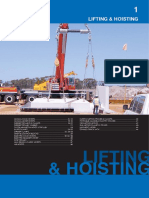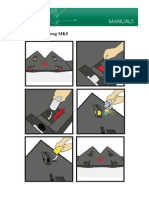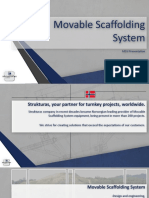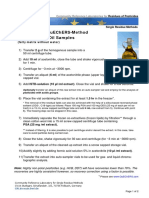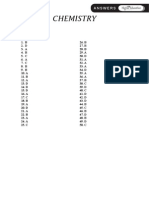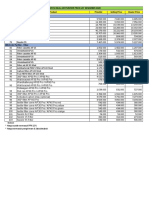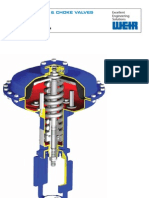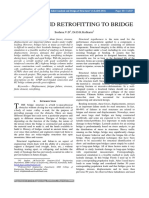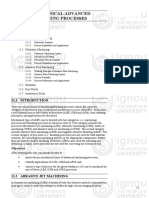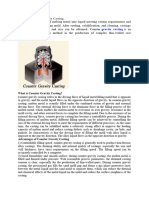API 682 e4 BALLOT DRAFT
ISO 21049 FDIS (?)
Henri Azibert - Ralph Gabriel
�Overview of API-682
First Edition
2
Released in October 1994
First complete seal standard
Intended to default to proven sealing solutions
�Mission Statement
3
This standard is designed to
default to the equipment types most
commonly supplied that have a high
probability of meeting the objective
of a least three years of uninterrupted
service while complying with
emissions regulations.
�Publication Dates
4
API 682 1st edition issued 1994
API 682 2nd edition issued July 2002
ISO 21049 issued 2004
API 682 3rd edition issued September 2004
API 682 4th edition in progress by taskforce
Approved by API
Will not be an ISO 21049 document
DIS and FDIS 21049 have been reviewed worldwide
Disagreement between ISO and API
Scheduled to be published in 1Q 2013 as an API only document
�API 682 Taskforce
5
1st Edition Taskforce was refineries only
2nd and 3rd Edition Taskforce
included chemical plant representatives
included European representatives
4th Edition Taskforce
Chairman Rick Eickhoff, ExxonMobil
Gordon Buck
Henri Azibert
Mike Huebner
.
�New Concepts in
1st Edition
6
A different kind of Standard
Seal types
Configurations
Qualification testing
Seal selection procedure
Tutorials
�Background for
2nd Edition
7
Success of the First Edition
Applications outside of refining
Applications to non-API 610 pumps
Advancements in sealing technology
Creation of an international standard (ISO 21049)
�Overview of Changes in 2nd Edition
8
Expansion of scope
Separation of pump and seal standards
New seal types
Expanded seal configurations
Introduction of seal categories
Testing requirements for new seal types
New piping plans
Modified selection procedure
Lets take a look at those changes
�New Seal Types in 2nd
9
Containment seals
Non-contacting dry-running
Contacting dry-running
Non-contacting liquid seals
Dry running dual seals
These new seal types often required
New designs, especially face designs
New materials
New piping plans and systems
�Seal Arrangements in 2nd
10
Arrangement 1
Single seal
Arrangement 2
Dual non-pressurized seals
Expanded to include dry running containment
seals
Arrangement 3
Dual pressurized seals
Expanded to include dry running gas barrier
seals
�Seal Categories in 2nd
11
Different applications may require different levels of
seal sophistication
Practice during 1st Ed. was to specify modified
API-682 seals
Size restrictions because of pump construction
Cost impact of 1st Ed. seals
Categories were often discussed as
API seals (normal and heavy duty)
ANSI seals
�Operating Ranges
12
600
500
psig
400
1st Ed
300
200
100
0
-100
100
200
300
400
F
500
600
700
800
�Operating Ranges
2nd vs 1st
13
2nd Ed
Cat II & III Seals
600
500
psig
400
1st Ed
300
Cat I Seals
200
(2nd Ed)
100
0
-100
100
200
300
400
F
500
600
700
800
�3rd Edition Overview
14
3rd Ed API 682 was almost exactly same as 2nd
Aligned API 682 with ISO 21049
Most changes were editorial
�Scope of Revisions to 4th
15
Original intent of 4th edition
Include and extend 3rd edition
Edit 3rd edition for errors and clarity
Consistency with ISO 13709 / API 610
Address comments submitted to API about 3rd Ed
Revisions
Minor
Major
New material
�Minor revisions to 4th
16
Scope
ES is out-of-scope not a seal type
Organizational
More definitions
Moved qualification test details to Annex I
Described seal hierarchy
Revised data forms (essentially same data)
Technical
Plans 53A, 53B, 53C to have equal working volumes
Seal code revised
�Major revisions to 4th
17
Pipe / Shipping Plugs
Clearances
Configurations
Piping Plans
Qualification test details
Forms revised
Tutorials expanded
�Current Status
18
As of February 2013
Completed the API and ISO DIS and FDIS reviews
FDIS comments received but disagreement
between ISO and API
A ballot has been submitted to API Member
Ballot comments were received and responded to
in December of 2012
Publication date is expected in early 2013
Lets
look at the details
�Scope
Section 1
19
Sealing systems for centrifugal and rotary pumps used in the
petroleum, natural gas and chemical industries
It is applicable mainly for hazardous, flammable and/or toxic services
where a greater degree of reliability is required for the reduction of
both emissions to the atmosphere and life-cycle sealing costs.
It covers seals for pumps with diameters from 20 mm (0.75 in to 110
mm (4.3 in).
Applicable to new and retrofitted pumps per ISO 13709 (API 610) and
ASME B73.1 and ASME B73.2, and API 676. (No longer reference to
ISO 3069)
�Definitions
Section 3
20
The longer, more involved definitions have been moved from Section 3
into the general body of the standard. For example, the definitions of
Arrangements, Categories and Types have been moved into Section 4.
The Type A and B seals are no longer defined as having rotating flexible
elements and Type C is not defined as having a stationary flexible element.
Instead, the design choice of having the flexible element rotate or remain
stationary is independent and said to be technically equivalent.
The definitions have been revised to be more consistent with terms that
are used in the industry in general. Yet some traditions are hard to break
through; for example the definitions of seal ring and mating ring were
essentially retained even though in some designs the very same physical
seal ring can either be a seal ring or a mating ring.
�Section 4 - Sealing Systems
Seal Hierarchy
21
�Section 4 - Sealing Systems
Configurations
22
Three Arrangements
Single
Dual unpressurized
Dual pressurized
Interface
Contacting
Non contacting
Liquid vs. gas
Throttle bushing type
�Generic Figures
23
�General
Section 5
24
Definitely minor changes
Addition of parentheses around customary
units
Lets go to some important changes in
Section 6
Design Requirements
�Pipe plugs
25
Previous editions required metal pipe plugs in gland plate
Same plug material as gland plate material
No PTFE tape or anti-seize compound
Anaerobic lubricant / sealant
Changed to plastic shipping plug
International red plug with yellow tag
Metal pipe plugs bagged and shipped with cartridge
�Shipping Plugs
26
Plastic shipping plugs
Warning tag required
�Major Change:
Clearances
27
1st, 2nd, 3rd Ed specified clearances for
Fluid volume (thinking of seal OD to seal
chamber)
Pumping ring (thinking of pumping ring OD to
seal chamber)
Bushing (thinking of bushing ID to sleeve OD)
4th edition added specifications for sleeve OD to
stationary parts
�Clearances
28
Clearances are based on shaft diameter
Minimum Clearances
Maximum clearances
outside of rotating part to inside of chamber or gland
Outside of a seal part to inside of another seal part
Outside of a circulation device to inside of gland
Outside of a rotating part to inside of a containment
fixed bushing (Containment Seals configurations)
Outside of sleeve to inside of floating bushing
Outside of sleeve to inside of fixed bushing
Examine the table of clearances
�Clearances
29
This clearance is primarily for fluid presence
(shown as radial clearance)
�Clearances
30
This clearance is to prevent
rubbing
- new, not previously specified
(shown as
radial
clearance)
�Clearances
31
This clearance is to prevent rubbing
(shown as
radial
clearance)
Variations
1st:
6mm (0.25 in)
2nd, 3rd: 3mm (0.125 in)
�Clearances
32
Variations
1st:
NA
2nd, 3rd: 3mm (0.125 in)
(shown as radial
clearance)
This clearance is to provide isolation
�Clearances
33
Throttle bushing clearances are unchanged from 3rd Ed
�Clearances
34
�Clearances with Caution
35
The intent of setting minimal clearances should in no way be construed
as implying that any seal component can be used to restrict shaft
movement in the event of bearing failure or other machinery or operation
problem.
The importance of having sufficient design clearance to ensure adequate
reliability and personal safety in hazardous, toxic and flammable services
is paramount.
Diametral clearances may be compromised in the event of the following
scenarios:
Wear of shaft bearings beyond their design limits
Operation of the pump beyond its allowable operating range
Existing pumps that have damaged, corroded or worn parts that control the radial
location of the shaft to the casing.
�Clearances with Caution
36
These minimal clearances will be adequate in
equipment that is built and/or maintained to the
specifications of ISO 13709 and ANSI B73.
For other equipment built, repaired, or operated to
different specifications these clearances might not
be sufficient. Larger clearances should be
considered for:
Pump designs unable to conform to ISO 13709, API 610,
ISO 21049, API 682 and ANSI B73.1 and B73.2.
Pumps installed with mounting and flange strain, from
connecting pipe-work, beyond the recommended limits
of those standards
�Clearances with Caution
37
These minimal clearances are to prevent contact between
rotary and stationary parts, but internal clearances in dual
seals also need to be sufficient to insure proper circulation of
the barrier/buffer fluid and cooling of the seal faces
This is particularly important in face to back configuration
where barrier/buffer fluid circulation to the inner seal is
inherently physically remote from the connections. Inadequate
cooling of the inner seal can result in reduced seal reliability.
Selection of 3CW-BB or FF configuration or use of process
fluid seal chamber cooling may resolve an inner seal cooling
problem.
�Less Prescription
38
An example of being less specific is found in the requirement for
positive retention of seal components under reverse pressure
conditions (either vacuum or internal vs. external pressure).
The new edition now provides alternative figures and lists them as
examples of such designs.
KEY 1 retaining feature
a)
Positive retention
b)
Dbi Dm Dbo
Pressure retention (with
L-shaped mating ring)
�Less Prescription
39
Another example of making recommendations more generic is
found in the section about distributed flush. The figures are
shown for rotating as well as stationary seals and it is clearly
stated that:
a)
These are only examples other configurations may be used.
Rotating flexible element b)
Rotating flexible element c) Stationary flexible element
�Configurations
Section 7
40
More emphasis on configurations
Almost any configuration is OK
F-B, F-F, B-B is OK
Rotating or stationary springs are equivalent
Configurations must be tested
More designs are recognized for pumping rings and
outlets. Performance is verified through
performance testing.
Tangential outlets are no longer specifically listed
as preferred.
�Configurations
41
A change has been made to the specification for
throttle bushings.
A fixed bushing is now only for category 1
(previously it was for categories 1 and 2)
Floating bushings are required for categories 2 and
3.
In addition, segmented carbon bushings are now an
option for Category 2 and Category 3 seals
�Seal Configurations
42
�Accessories Section 8
43
Filling, Venting, and Draining
Pipe and Tubing Specifications
Components
Air and Water Coolers
Strainers
Cyclone Separators
Flow Control Orifices
Reservoirs 3 & 5 gallon minimum
Accumulator Sizes Plan 53B
Piston Accumulators Plan 53C
Collection Reservoirs Plan 65A/B & Plan 75
Gas Panels Plan 72 & 74
�Instrumentation Section 9
44
In general, transmitters will replace switches!
Local indicators
To get switches they must be specified!
Output signal type
Indicating or non-indicating
Analogue or digital
Housing and power supply requirements
�45
Section 10
INSPECTION
TESTING
PREPARATION FOR SHIPMENT
�Test Requirements
46
Testing
Individual seal testing
Type testing
Qualification
Fluids
Sizes
Steady state /Cyclic
Seal types
Seal arrangements
Component
Integrity
Hydrostatic testing
- Seal chambers
- Gland plates
- Reservoirs
- Heat exchangers
Cartridge
Integrity
OEM
Air test
- Single
- Dual
Pump
performance
test
�Testing
47
Qualification tests have existed since 1st Ed
Details of qualification testing moved to Annex I & updated
Assembly integrity test retained in Section 10
Reorganized sub-section
No change in details
If glands are made from bar stock they dont necessarily need to be
hydrotested
�Data Transfer Section 11
48
Forms from Annex C & Annex E
Other documents as specified in the order
Inspector Checklist Annex H
�Annexes
49
Many details are in the Annexes
Some are Informative
Some are Normative
Contents
A - Seal selection - Informative
B - Materials - Informative
C - Data sheets - Informative
D - Seal codes - Informative
E - Data requirement forms Normative
F - Tutorial - Informative
G - Piping plans - Normative
H - Inspector checklist - Informative
I - Qualification testing - Normative
�Annex A: Seal Selection
50
Informative
Summaries of
Seal selection
Categories 1, 2, 3
Arrangements 1, 2, 3
Seal types A, B, C
Engineered Seal Design
Tutorial
Tables
Logic diagrams
Piping Plans
Brief Tutorial tied to selection sheets
�Alternate Selection Method
51
Proposed by Michael Goodrich, 2010
Risk Based Pump-Seal Selection Guideline Complementing
ISO 21049 / API 682
Selects seal arrangement
Based on
UN Globally Harmonized System Hazard Codes
OSHA Globally Harmonized System of Classification &
Labeling of Chemicals
Material Safety Data Sheets
Presented at 2010 Pump Symposium
Compares favorably to choices made by experienced engineers
�Seal Selection Logic
52
�Materials Annex B
53
Content and tables expanded to be more global
More tutorial in nature
Much more information on Seal Face Materials,
Elastomers, and Bushings
�Datasheets Annex C
54
Datasheets are entirely new
If an option is allowed by the standard then the choice must be
included on the datasheet
Two pages
Variations of the form are OK
Must include same information
�Datasheet Details
55
�Seal Codes - Annex D
56
Informative
8 position segment code
Different from 1, 2, 3 Edition
Different from API 610
But uses some of the old material codes
F = fluoroelastomer
N = carbon vs reaction bonded silicon carbide
etc
API 682 reclaims custody of old API 610 code
Example: BSTFL
Old 610 code is still obsolete
�4th Edition Seal Code
57
Gaskets
Containment
Faces
1 2 A P F O 050 11/52
Type
Arrangement
Category
Shaft Size
Piping Plan
�Data Requirement Forms - Annex E
58
Annex J, 3rd Ed was moved/combined into Annex E
Two Data Requirement Forms
Inquiries and Proposals
Contracts
�Technical Tutorial Annex F
59
Seal Leakage
Vapor Pressure Margins
Calculations
Piping Plans
Set Screw holding power
Etc.
�Plan 53B Details
60
Annex F includes details and calculations for 53B
�Piping Plans
Think Piping Plan not Flush Plan
Pipe and tubing
Single and dual seals
Symbol Library
PI = Pressure Indicator
PIT = Pressure Transmitter with Local Indicator
Combined descriptions, schematics and illustrations
Piping plan figures do not specify features such as
Throttle bushings
Connections and locations, etc
Rotating, stationary, configuration, etc
See other clauses for features other than piping schematics
61
�New Piping Plans
62
Plan 03
Plan 55
Leakage detection and collection for Arrangement 1
Plan 66 A/B
external pump for Arrangement 2 buffer fluid
Plan 65 B
no piping
special seal chamber promotes circulation
Leakage detection and routing for Arrangement 1
(See Clause 7.1.2.3)
Plan 99
Engineered piping plan not defined by other plans
�63
Piping Plan 11
Most popular piping
plan
Used here as example
Piping schematic
Seal illustration
Text
�Plan 03
64
Internal circulation from shape of seal chamber
�Plan 55
65
Dual unpressurized seals
-> Arrangement 2
(Tandem Seals)
Flush to inner seal is
not part of Plan 55
Plan 55
External
Source
Plan 65A
66
Drain
Connection on
bottom!
Atmospheric leakage
collection and detection
Valve instead of
orifice
�Plan 66A
67
Single seals
Leakage management
Leakage detection
PIT
to leakage
disposal
Two throttle bushings
�Plan 66B
68
Single seals
Leakage management
Leakage detection
PIT
to leakage
disposal
5 Drilled
Plug in 4
One throttle bushing
Floating Type
�Inspectors Checklist Annex H
69
�Qualification Testing
70
Liquid seals
No changes for FB configurations
Different test for BB and FF
Containment seals
Gas matched to test liquid
�Qualification Test Concepts
71
Dynamic (3600 rpm)
Base point pressure and temperature
Steady state for 100 hours minimum
Static
Cyclic
simulated upset cycles
Final Static Test
�Organization of Testing
72
�Organization of Testing
73
Complete matrix of tests would be about 4000 tests!
All seals, arrangements, configurations, etc are not tested in all
fluids
Configurations are
mapped into the test plan
�Qualification Tests
Non-Specifics
74
Fixed throttle bushings
Dynamic secondary seal material
Except durometer for O-rings
Static secondary seal material
External pumps (Plan 54)
�Qualification Test Conditions
75
�Seal Sizes for Testing
76
Based on balance diameter
Previously nominal 2 and 4
Cat 1 seals typically smaller
Changed to
Cat 1
Cat 2 and 3
1.5 to 2
2 to 3
3 to 4
4 to 5
�Face Materials Qualification
77
Normally two seal sizes are tested
Additional materials may be qualified with one test
Tested with large seal size
Tested against a previously qualified material
A and B qualified by testing small and large sizes
C qualified for use with B by testing only large size
D qualified for use with A by testing only large size
C and D not qualified for use together
�EPA Method 21
Emissions Monitoring
78
Clarifications needed for API 682:
Method 21 is a manual method intended for use in the field
Seal OEMs use data acquisition systems during qualification testing
Changes
Use Method 21 as a reference
No changes to the 1000 ppm criteria
�Questions ?
79














